So: you want to write a blog post. Allow me to be the first to congratulate you. Writing may be one of the biggest boondoggles on the planet. It’s fun, can be cathartic, and when done well/correctly, it can pay some serious dividends for you, and for your business.
How do I know? I’ve penned a few blog posts in my day. Some of them get tens of thousands of reads each month (humblebrag). I say this not to toot my own horn, but to tell you that I am uniquely situated to give advice on how long your blog post should be.
Want the quick answer? Like most things, it depends.

I know. I hate that answer too. But it’s true. Get a solid grasp on your use case, and combine it with the rules I’m about to talk about, and I promise that by the end of this post, you’ll have a pretty damn good idea how long your blog post should be.
And because we’re is all about helping business owners succeed through smart digital marketing, we are going to frame this discussion through precisely that lens: the marketer or business owner who is leveraging blogging as part of a broader content marketing strategy to drive traffic, scale leads, and grow revenue.
But hey, even if that’s not you: I have a feeling you’ll get some value out of this post anyway.
How long should a blog post be? What the data says
If you’ve spent some time combing through search results looking for the answer to this question, you’ve probably seen that the results are mixed. Here are some answers from the top results:
- 1,500-2,000 words
- 3,000+ words
- 2,100-2,400 words
- 300-600 words
Basically, the internet says a good blog post is anywhere from 300-3,000+ words long. That’s not exactly a helpful range.
To get a more data-supported range, we looked at our top 10 posts from the last year and from the last three years. We found our best-performing blog posts average 2,700-3,000 words.
That’s a little more direct of an answer, but it doesn’t take into account many factors that should influence your blog post length. That’s where these rules come in…
3 rules to determine how long your blog post should be
Here are my top three hard-and-fast rules to live by if you want to write a blog post that gives your business the shine and visibility it deserves.
Rule #1: When in doubt, make it long
You heard it here first: length is not everything. And we’re going to talk precisely about why length is not everything in the sections to come. But as a general rule to live by, deep, long-form content is the content that readers like.
Why? Because generally speaking, length equates to value. And–highlight this next point as furiously as you can–the thing search engines care about the absolute most is how much value, on average, readers are getting out of your blog post.
So if, like marketing guru Seth Godin, you already have millions of readers subscribed to your short-form newsletter, or if you’re writing a blog post with a goal of repurposing it on LinkedIn, by all means, keep it short and sweet.
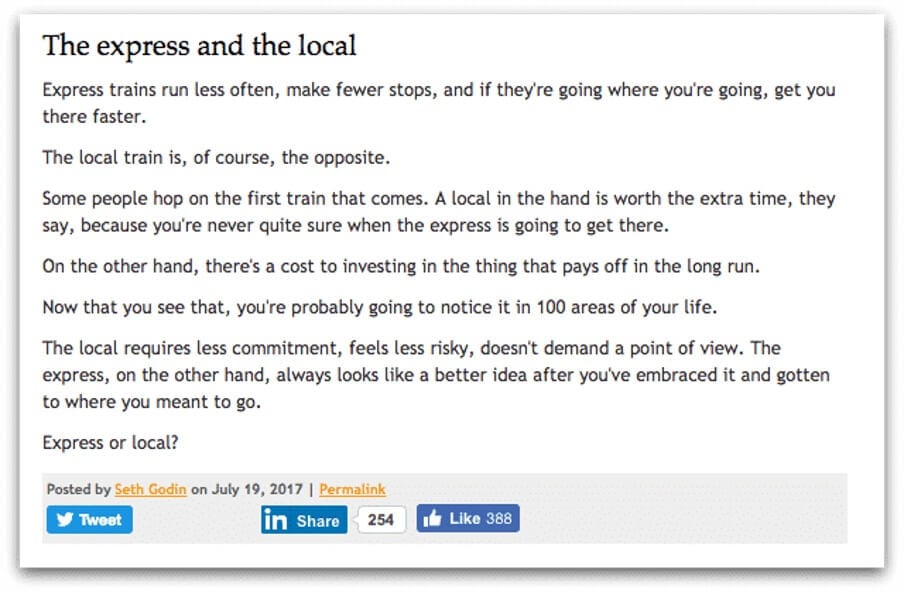
But if you’re writing a blog post with the intent of rocketing to the top of Google’s search results, and driving thousands of free eyeballs to your website? Then you need to talk at length, and go deep, on your subject.
I’m not talking about being wordy for the sake of writing a long blog post. I’m talking about giving useful examples, giving a thorough explanation of concepts, and attacking your topic in a way that will leave readers thinking: Damn, that was comprehensive AF.
If you’ve already written a bunch of long-form content for your website, I know what you’re probably thinking: Man, I haven’t really written at length on enough of these topics. That’s okay. Because you already have the scaffolding of a great blog post. All you have to do is beef it up.
If the person I’m describing is you, here’s a quick pro tip: any SEO software worth its weight in gold (think: Ahrefs, SEMrush, Moz) is going to have an audit tool that surfaces thin content for you. Thin content is just that: there are not enough words on the page to meet the requirements for true topical expertise.
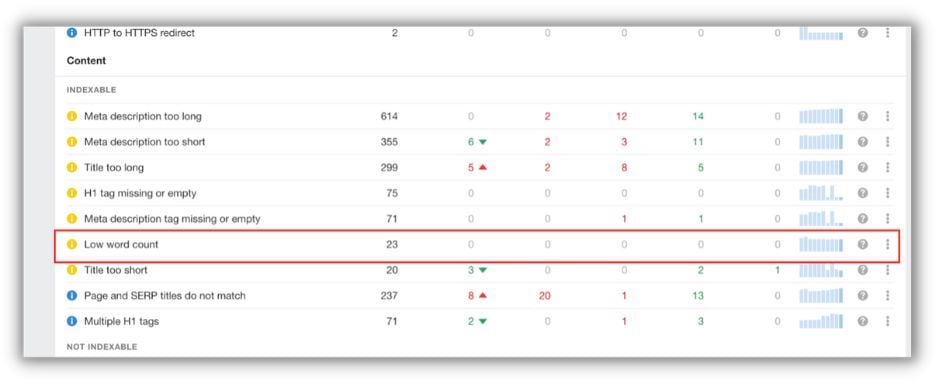
You can use reports like these to discern where it’s necessary to write more. Or, you can simply audit your existing content manually and give yourself an honest assessment: how often am I truly going deep on the topics my readers or customers care about?
Rule #2: Above all, deliver value
This easily could have been our first rule, because it’s probably the most important. But I think it’s useful to talk about value through the lens of length, because length is really critical as a component of SEO-driven content marketing.
But guess what? As I said in the first section: length is not everything. And where length fails, you’ll almost always find that it’s because the piece did not deliver enough value.
Let me explain: Google and Microsoft have hundreds of factors they look at every day when determining the order in which they rank content. We call these things ranking signals (or factors).
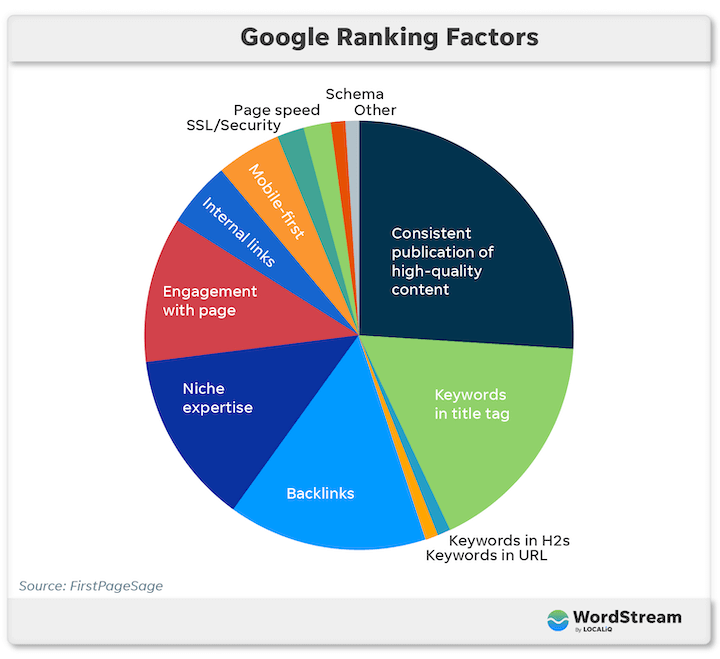
See that big red slice of the pie? That’s page engagement. When Google is assessing how valuable or not valuable your blog is to a user, it’s primarily looking at how effective your blog is at getting the reader to engage.
The critical metric to look at here? Dwell time. You can think about how long a user spends on your page, on average, as one of the strongest indicators of whether your blog post has delivered value.
Dwell time is not going to show up in your Google Analytics reports. However, Average Session Duration is, and it is a great metric for keeping tabs on how long your readers are spending on your blog posts. Or, if you’re using Google Analytics 4, which we all will be soon, you can use Average Engagement Time.
Other engagement metrics, like Engaged Sessions (the number of sessions that lasted longer than 10 seconds, or had a conversion event, or had 2 or more screen or page views), and Engagement Rate (number of Engaged Sessions divided by total sessions) are also really strong proxies for traffic quality and are readily available to you in GA4.
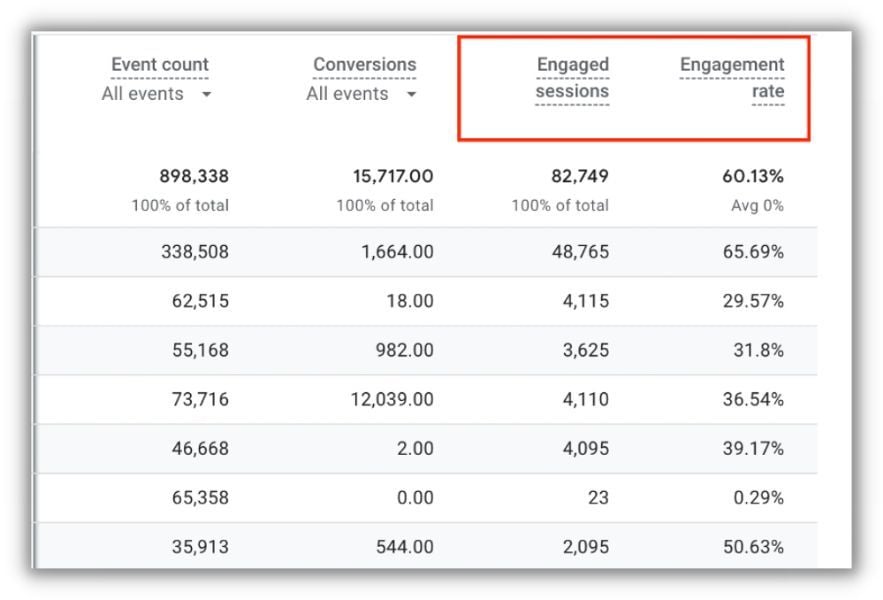
How do you increase dwell time? Well, it stands to reason that the higher your word count, the longer the reader should stay on the page. But what if your lengthy blog post isn’t saying much of anything at all? Then you’re going to have a difficult time outranking your competitor. Even if they wrote 500 words and you wrote 1,500.
Consider how big of an impact images, videos, infographics, and other visual examples can make on how long you, personally, spend reading a blog post. Deep concepts will always increase dwell time, because they force readers to evaluate what you’re writing about, and how to apply it to themselves. It’s not all just window dressing.
But if you can combine deep concepts with compelling visuals that lend context to the text and enhance the value your reader is getting out of the post? Then you’re really cooking with gas.
Rule #3: Do your research
Man, it’s quite possible that not one of these rules is more important than another! Because you can’t really live by the first two rules without taking rule #3 into account.
Let’s go back to what I said in the introduction about context. About knowing your situation, your niche, your competition, and above all, what you’re trying to accomplish with your blog post.
78% of marketers identify keyword research as a high-impact practice for driving new traffic.
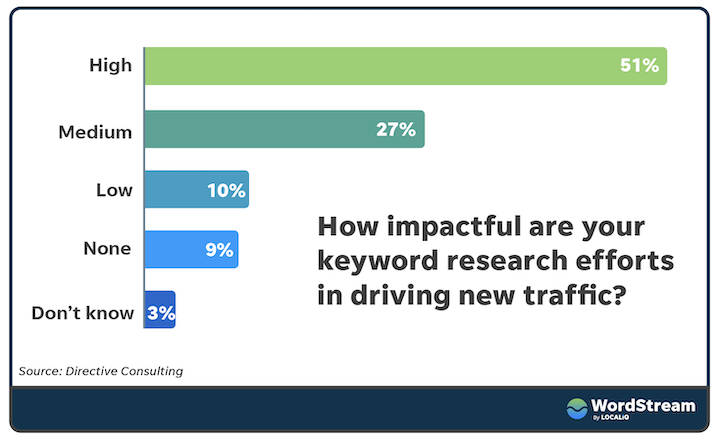
But the purpose behind keyword research goes beyond simply optimizing your H1s and H2s. If you want to know exactly how long to make your blog post, look no further than the keyword you’re trying to rank for.
Let’s look at an example. Let’s say you’re a roofing company. You’ve been running search ads targeting prospects who are looking for roofing services, but you want to start driving organic traffic from people who are more in the “consideration” phase of the buying process.
You use your favorite keyword research tool, and find that the keyword “how to install metal roofing over shingles” has some nice search volume. The intent is exactly what you’re looking for: this person is probably considering the DIY route, but with some education, which your blog post will provide, you can convince them that metal roofing is a job best left to professionals (i.e. you).
How long should your blog post be? Well, you can simply enter the query into Google, copy and paste the text from the top three ranking blog posts into a word counter, average them out, and write a post that exceeds that number. Or you can use your favorite SEO tool (I’m a fan of Ahrefs) to get all this information at a glance.
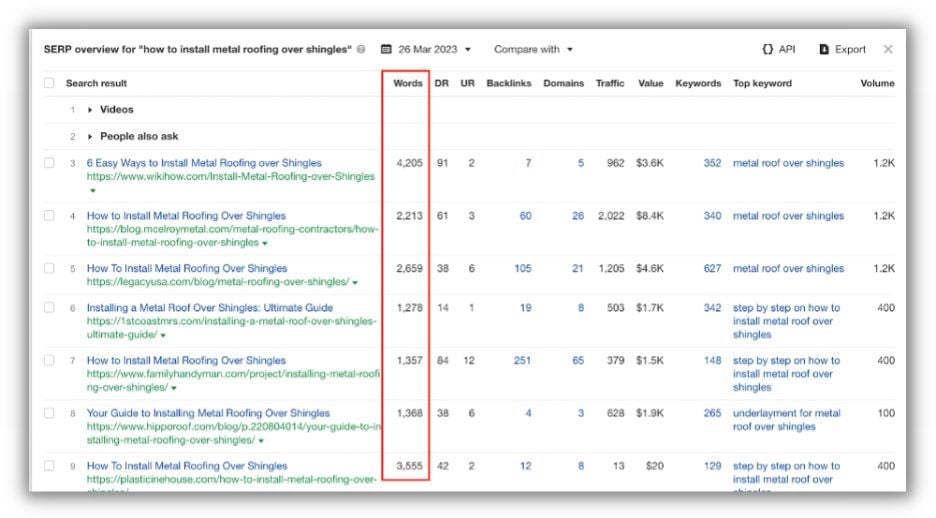
As you can see, the top-ranking post for this query has a whopping 4,205 words. That’s a beast of a post. But even if you want to rank in the top 10, you’re probably looking at a minimum of 1,500 words based on the other posts in this SERP (Search Engine Results Page).
This birds-eye view of the SERP is incredibly useful when determining blog post length, and not just because you’re getting word count totals. You might be saying, Wait a minute, the post in the 7th position only has 1,357 words. How is it outranking the post in the 9th position, which has 3,555 words?
Well, the post in the 7th position has a higher Domain Authority, and more backlinks, which, you guessed it, are two more really critical ranking factors.
Do you have a fairly new website or business, or are you still growing your topical authority? Don’t despair: check out the post in the 6th position. It has the lowest Domain Authority in the bunch, the lowest word count, and a pretty slender backlink profile, and yet it’s still doing pretty well here. How is that possible?
That’s the magic of rule #2 at work. If you can deliver a blog post that truly delights and informs your readers, you give yourself an amazing chance to rank and drive traffic, regardless of all the other factors in play.
Make it long, make it valuable, and do your research!
There you have it! As I mentioned, there are a number of factors that go into determining how long a blog post should be. But you can do a heck of a lot worse than honing in on these three:
- When in doubt, make it long
- Deliver value
- Do your research!
If you can outwrite your competition, deliver more value, and take a research-based approach, I guarantee people will read and love your blog post.
I hope you loved this one! If you have any questions or comments, feel free to hit me up on LinkedIn. Happy writing!







